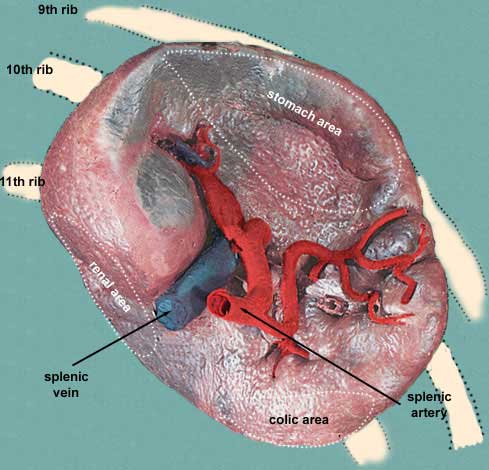the ‘umble spleen.
It lurks tucked up behind the stomach, a soft black leather purse moulded to the contours of adjacent organs like a dark shadow, the sort of organ you’d ignore, a remnant, a vestige, a redundancy. No wonder surgeons removed the spleen with impunity if they were operating on the stomach. But this ain’t no vestige. Remove it at your patients peril. People without a spleen have six times the risk of getting pneumonia and other infections and a fifty percent increase in heart attacks. Be it ever so ‘umble, the spleen is none the less important.
Cut into its surface. A red black pulp like raspberry jelly oozes out and between the pulp are islands of white tissue, called Malpighian tubercles.
The red pulp is composed of large blood spaces or sinuses lined with columns of cells. The blood passes slowly though the sinuses and the cells filter it, destroying bacteria, viruses, protozoa . Similar arrangements of fixed macrophages exist in the sinuses of the liver (Kupffer Cells) and in the lymph nodes. Together they comprise what is known as the body’s ‘reticulo-endothelial system’. But the spleen also destroys tired red blood cells, worn out and dysfunctional after their 120 day journey round the vascular system, recycling the haemoglobin to bile pigments and iron stores.
The white nodules contain lymphoid follicles rich in B lymphocytes, which produce antibodies and sheaths of T lymphocytes, responsible for ‘hand to hand’ cellular conflict. They are also major producers of monocytes, which are despatched to sites of injury where they transform into dendritic cells and macrophages and assist wound healing. So both white and red components of the spleen are important parts of the immune system. The same functions can be carried out in other parts of the body, but without a spleen, immunity is seriously compromised.
In other mammals, the spleen is also an important reservoir of blood. In the horse, 30% of the blood is stored in the spleen; in the dog 15%. Operate on a dog and you can see the spleen shrink before your eyes. The spleen used to produce new red blood cells but loses that ability just before birth when that function is taken over by the bone marrow.
Doctors have known about the spleen since ancient times. It was, they thought, the origin of black humours, the source of melancholy (literally black bile) and hypochondria (below the ribs). In the eighteenth century, women were often diagnosed as suffering from The Spleen when they were sad, bad tempered and out of sorts in mind, body and spirit. Alternatively they might be said to be suffering from the Vapours (of the Spleen). The term splenetic indicated that somebody was in a foul mood, though the same term in French meant sad and melancholic.
So don’t ignore the spleen or provoke it, for if it ever gets ‘vented’, take cover immediately!
The little bastards that that bloody insect injected into me have swollen my spleen from 11cm to 15cm. The insurance company seem to think it will explode in the low pressure environment of the aircraft cabin. It’s a solid organ, I insist! Physics doesn’t work like that! It’s enough to give anybody The Spleen!



